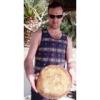
“Rossisky” using the Three Stage Auerman Process; Pain au Levain using Rye Sour and Wheat Leavens; Panned “Wholewheat-style ..
“Rossisky” using the Three Stage Auerman Process; Pain au Levain using Rye Sour and Wheat Leavens; Panned “Wholewheat-style” Loaves with mixed leavens.
Refreshment Régimes:
- 1. Rye Sourdough
Refreshment One. Saturday 16:00
Material | Weight [grams] |
Rye Sour from Stock | 90 |
Bacheldre Organic Dark Rye Flour | 60 |
Water | 100 |
TOTAL | 250 |
Refreshment Two. Sunday 07:30
Material | Weight [grams] |
Refreshment One | 250 |
Bacheldre Organic Dark Rye Flour | 300 |
Water | 500 |
TOTAL | 1050 |
Refreshment Three. Sunday 15:00
Material | Weight [grams] |
Refreshment Two | 1050 |
Bacheldre Organic Dark Rye Flour | 130 |
Water | 215 |
TOTAL | 1395 |
- 2. Wheat Levain
Refreshment One. Saturday 16:00
Material | Weight [grams] |
Wheat Levain from Stock | 20 |
Marriage’s Organic Strong White Flour | 100 |
Water | 60 |
TOTAL | 180 |
Refreshment Two. Sunday 07:30
Material | Weight [grams] |
Refreshment One | 180 |
Marriage’s Organic Strong White Flour | 200 |
Water | 120 |
TOTAL | 500 |
Refreshment Three. Sunday 15:00
Material | Weight [grams] |
Refreshment Two | 500 |
Marriage’s Organic Strong White Flour | 315 |
Water | 189 |
TOTAL | 1004 |
************************************************************************************************
- 1. “Rossisky” using the Three Stage Auerman Process
See Refreshment Régime above for sour building. The “Scald” was made at the same time as the 3rd refreshment. The “Sponge” was made 21:00 Sunday night. The final paste was made 09:00 Monday morning.
Material/Stage | Formula [% of flour] | Recipe [grams] |
1. a] Built Sour [see above] |
|
|
Bacheldre Organic Dark Rye Flour | 24 | 240 |
Water | 40 | 400 |
TOTAL | 64 | 640 |
|
|
|
1. b] “Scald” |
|
|
Crystal Barley Malt Powder | 6 | 60 |
Bacheldre Organic Dark Rye Flour | 20 | 200 |
Boiling Water | 39 | 390 |
TOTAL | 65 | 650 |
|
|
|
2. “Sponge” |
|
|
Built Sourdough [from 1. a]] | 64 | 640 |
“Scald” [from 1. b]] | 65 | 650 |
TOTAL | 129 | 1290 |
|
|
|
3. Final Paste |
|
|
“Sponge” [from 2.] | 129 | 1290 |
Bacheldre Organic Dark Rye Flour | 50 | 500 |
Salt | 1.5 | 15 |
Water | 6 | 60 |
TOTAL | 186.5 | 1865 |
Overall % pre-fermented flour | 24 + 26 =50 | - |
Overall % hydration | 85 | - |
FACTOR | 10 | - |
Method:
- Build the sour as above. Make the “scald” at the same time as the final refreshment of the sour, by pouring boiling water onto the flours and mixing. Allow to cool to room temperature, covered.
- Make the “Sponge”, by combining the Built Sour with the “Scald”. Leave to ferment, covered, for a further 12 hours [this proved to be too long; recommended time is 4 hours!]
- Add the remaining ingredients to the “Sponge” to make the final paste. Target temperature is 29 - 30°C.
- Bulk Ferment for one hour.
- Scale and divide: I made one loaf in a pan @ 1kg, and one shaped round and proved in a banneton using the remaining paste.
- Bake on the “dead” wood-fired oven.
- Cool on wires, and set aside wrapped in linen cloth for 24 hours, before slicing.
- 2. Pain au Levain using Rye Sour and Wheat Leavens
See Refreshment Régime above for the rye sour and wheat levain building.
Material/Stage | Formula [% of flour] | Recipe [grams] |
1. a] Wheat Leaven |
|
|
Marriage’s Organic Strong White Flour | 15 | 300 |
Water | 9 | 180 |
TOTAL | 24 | 480 |
|
|
|
1. b] Rye Sourdough |
|
|
Bacheldre Organic Dark Rye Flour | 9 | 180 |
Water | 15 | 300 |
TOTAL | 24 | 480 |
|
|
|
2. Final Dough |
|
|
Wheat Leaven [from 1. a] | 24 | 480 |
Rye Sourdough [from 1. b] | 24 | 480 |
Carrs Special CC Flour | 60 | 1200 |
Allinson Strong Wholemeal | 16 | 320 |
Salt | 1.8 | 36 |
Water | 44 | 880 |
TOTAL | 169.8 | 3396 |
% overall pre-fermented flour | 24 | - |
% overall hydration | 68 | - |
FACTOR | 20 | - |
Method:
- Build the sour and leaven as above.
- Autolyse flours, water and rye sourdough for the final dough for 1 hour.
- Combine all materials for the final dough and mix to develop.
- Bulk proof 1½ hours
- Retard overnight, covered.
- Scale and divide: one @ 1500g, one @ 700g and one just short of 1200g. Mould round and proof in prepared bannetons.
- Final proof: 3 hours
- Bake: Decant each loaf onto the peel, score an “S” shape onto the top, and set in the wood-fired oven to bake.
- Cool on wires.
- 3. Panned “Wholewheat-style” Loaves with mixed leavens.
These loaves are a request from a new-found customer who lives in the next village to us, and has been buying bread from the Village Bakery, Melmerby, where I used to work, for many years.
It’s as “plain”, as I go when working at home, and is largely wholewheat-based, which was the main tenor of the request. It’s also made in pans, to allow for breaking into small and easy quantities for freezing down.
The refreshment régimes for both the pre-ferments are shown above. The soaker was prepared at the same time as the final refreshments took place.
Material/Stage | Formula [% of flour] | Recipe [grams] |
1. a] Wheat Levain |
|
|
Marriage’s Organic Strong White Flour | 25 | 300 |
Water | 12 | 144 |
TOTAL | 37 | 444 |
|
|
|
1. b] Rye Sourdough |
|
|
Bacheldre Organic Dark Rye Flour | 6 | 72 |
Water | 10 | 120 |
TOTAL | 16 | 192 |
|
|
|
2. Soaker |
|
|
Gilchesters Organic Farmhouse Flour | 9 | 108 |
Salt | 10.8 | 129.6 |
Water | 0.2 | 2.4 |
TOTAL | 20 | 240 |
|
|
|
3. Final Dough |
|
|
Wheat Levain [from 1. a] | 37 | 444 |
Rye Sourdough [from 1. b] | 16 | 192 |
Soaker [from 2.] | 20 | 240 |
Allinson Strong Wholemeal | 60 | 720 |
Salt | 1.5 | 18 |
Organic Lightly Salted Butter | 1.5 | 18 |
Water | 37 | 444 |
TOTAL | 173 | 2076 |
% overall pre-fermented flour | 31 | - |
% overall hydration | 69.8 | - |
FACTOR | 12 | - |
Method:
- Build the leaven and sour as above, and prepare a cold soaker [2], at the same time as the final refreshment stage for each pre-ferment.
- Combine the rye sourdough, soaker, flour and water for the final dough for 1 hour autolyse.
- Add the remaining ingredients and mix to develop a strong dough.
- Bulk proof 1½ hours.
- Retard overnight in the chiller, covered.
- Scale and divide: 4 pieces @ 390g for the Pullman Pan, and one piece @ 516g for the smaller loaf. Mould round and rest, covered for 15 minutes. Shape and pan.
- Final proof for 3 hours.
- Bake in the wood-fired oven.
- De-pan and cool on wires.
Comments.
The Russian Rye paste was too stiff, and therefore slow to prove; always a worry from my experience, producing a tasty, but dense loaf of reduced quality. I fear the “zavarka” was too stiff, as a result of exuberance on my part boiling the water, resulting in excessive starch gelatinisation. Result? A very tasty dark loaf, but very dense!
I badly need more wood to fire the oven. It was pleasing to bake these 3 varieties, but I now acknowledge I need a regular supply of tinder dry, soft wood; cut small. The search continues…
Both the other doughs proved well and made good bread. Today was a lovely sunny day here in Northumberland; however, there was a really sharp frost overnight, so it was a challenge to keep the dough warm enough to enable active final ferment, given 2 of the doughs had overnight retard. The wholemeal looked particularly good. Oven spring in both was fine, and the crumb of the Pain au Levain with the 2 pre-ferments looks great. The crust? This is where the wood-fired oven is really coming into its own with wonderful radiated heat from the arched roof of firebrick.
I managed to sell 4 of the 7 loaves I made today and net £10 proceeds. My business adviser came to see me, and he left with a loaf he was happy to purchase, full of positivity about my progress, and other ideas I have too: a “pre-order Pizza Takeaway” service one night a week? Seems like a winner to me!
This is arriving on a pallet by courier tomorrow, and I can’t wait! An old 20 quart Hobart planetary mixer, but in excellent working order. So, making up to 10kg of dough at a time should be really easy moving forward.
http://www.flickr.com/photos/24731237@N03/6324106618/in/photostream
Happy Baking Everybody!
Andy

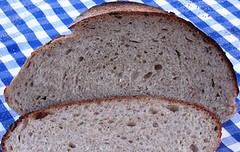

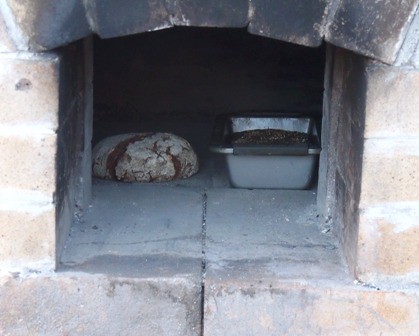




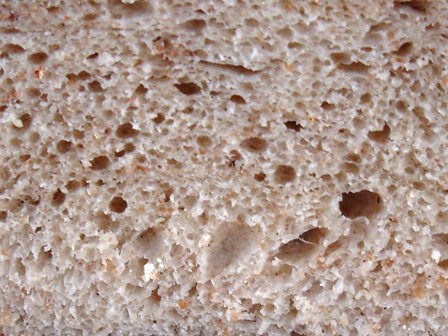
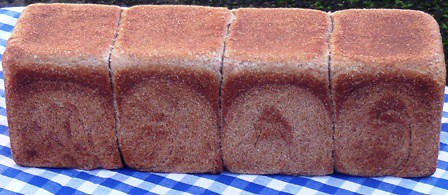

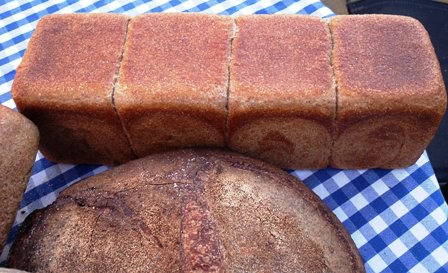




Comments
Gotta say Andy, I really like the look of the panned wholewheats. I know you say "plain" but they would taste amazing I am sure...
The crusts on the Pain au Levain with using two preferments look fantastic ... can see lots of cracking on the crust in one of the pictures. Do you find using the rye levain increases the colouring of the crusts? I am always a little dissapointed by the crusts on 100% wholewheats I make, but when I make a bread with sifted wheat and using two preferments (a rye and stiff wheat) I get amazing colouring and crust. I thought a read something about it in the past ... I could be imagining ... too much bread information stuck in my head :)
Have fun setting up your new toy...
Phil
Hi Phil,
Yes, indeed, the term "plain" came from a description of the types of bread preferred by the person who bought these 2 loaves. However, with a soaker made using local Northumbrian organic flour, and a generous portion of white leaven plus a touch of rye sour, you can imagine the taste would be great, I'm sure. Shame I didn't get to sample it, but we did get a loaf each of the other varieties, and they were lovely.
The crusts on my breads have altogether improved of late...in the case of the wood-fired oven, I find the radiated top heat from the arched roof is so significant. I also have a new and much better electric oven in the kitchen. From my experience a portion of whole rye adds a lovely reddish hue to the crust colouration; so I think your observations are probably quite correct.
Many thanks for posting your very generous comments
Best wishes
Andy
Just arrived with a courier half an hour ago.
20 quart Hobart mixer with bowl and 3 attachments; works perfectly, newly serviced!
It's 75cm tall, 50cm deep and 40cm wide....and it must weigh at least 80kg!
Andy
Great mixer Andy. In my experience, if you under utilize the mixer it will live longer than we do. Overloading and abusing is about the only thing that will bring about premature demise. Bringing a little beast like this into a home kitchen is the best thing since....................................(well, you fill in the blank).
Jeff
Hi Jeff,
Agreed on the build quality; this must be at least 40 years old; it's probably already as old as me! They really don't give out, and can be subjected to considerable abuse...although I will not be handing out that sort of treatment.
Over here we might use the phrase "built like a brick s__t-house"
I guess I need both the mixer, and the brick oven on the patio, of course!
Thanks for your kind words
Best wishes
Andy
great looking machine
i can see a great relationship developing.
we have a similar machine that is tagged out of use by OH&S as it has no guards to stop students getting their hands into the bowl (and it does happen) might be going cheap before to long but does have to go out to auction. will send som e pics soon.
in the meanwhile
I badly need more wood to fire the oven. It was pleasing to bake these 3 varieties, but I now acknowledge I need a regular supply of tinder dry, soft wood; cut small. The search continues…
to bad its 12,000miles to come and pick through the skip, you need to hunt around some of the handy persons and do a trade with wood off cuts for a loaf of bread, im sure you will end up with more than you can burn.
kind regards Derek
Hi Derek,
Yes, I'm sure you are right about sourcing wood through mutually beneficial trading arrangements; I will investigate further.
I'm all-too-familiar with the College Health and Safety Police!!!!!
Great to hear from you
Best wishes
Andy
hi Andy
here are some pics of the out of service Hobart and its replacement
i presume your holidays have been and gone hopefully enjoyable for you both
looking forward to mine in 2012 and catching up!
Andy, The process for the Rossisky is very involved with the rye sour, soaker and scald and sponge. I'm sure it gives an incredibly complex and delicious flavor. I was confused as to which of the pictures above were the Rossisky. I see in some earlier posts that you made this at the Village Bakery. And also that Auerman is used for Borodinsky. Were you making this for your own use or sale? Fabulous bake as always. -Varda
Hi Varda,
Andrew Whitley doesn't use the 3 stage process, as far as I'm aware.
Before I started at Village Bakery, they did use a scald. But this was allowed to cool sufficiently first before being innoculated with the seed rye sour. So, it was really only a single stage, as opposed to the 2 where scald and sour are combined to make sponge. At Village Bakery I made both Borodinsky and Rossisky loaves. Both varieties were 100% rye loaves, and neither used the 3 stage process. They were similar to how Andrew Whitley lists them in Breadmatters, but the hydration in both sour and final paste was slightly reduced on what he uses now, and the salt level was somewhat higher.
Yes, I first came across the Auerman process in relation to Borodinky.
The Rossisky loaves were made for home use, and I kept back the large mixed levain loaf. The other 4 were sold; my journey continues! The Rossisky loaves are the ones still in the oven! They were still baking when I took all the photos.
Many thanks for your very kind words
Best wishes
Andy
Andy, that mixer looks great!
I like how it puts the washing machine in the background in place ...
And what wonderful breads you made ...
If you were to bake this Rossisky in a domestic oven, how would you set the temperatures and times?
Best Wishes,
Juergen
Ananda!
I look to your bread with admiration. I do not remeber such a good loaf even in my Moscow childhood.
Thank you for your generous comment eliabel,
Sadly the all rye loaves didn't work out too well this time...they are the ones seen in the oven baking
For some reason the sponge never really took off...perhaps I left it too long, but I suspect I over-gelatinised the starch, so the hydration level in the final paste was wrong. I have had much greater success on previous occasions, for sure.
Best wishes
Andy
Andy, I belive (I might be wrong) than you can read Russian. If so, do you have an electronic version of the pre-war edition of "350 sortov xleba i xlebobulochnyx izdelii". It is a book full of interesting formula, wheat and rye bread and buns. If you don't have one and want it, I could send it to you. For all Russian bread-baking internet it was and it is still is a great source of inspiration and knowledge.
Hi eliabel,
Sadly, I don't read Russian. I do have the pdf with all the GOST Standard recipes, which is a revelation in itself, although minor in content compared to what you are posting about here.
Is there a reliable means to translate in on the web?
I'd love to have a read.
Very best wishes, and thanks
Andy
Hi Juergen,
Keep a container of water in your oven for steady steam. Use a lidded bread pan if possible. Bake at 160*C for at least 2 hours for a 2 kg loaf like this.
Good, you've seen my posts on HB and the excellent discussion Eric and I enjoyed.
When I work in College, I have access to what are known as "Combi" ovens. These are electric, and the nearest thing to the dreaded "rack ovens" so beloved of the industrial baker [wheel the rack in, shut the door, push the right buttons to start the programme, walk away, and come back only when the alarm goes off...wheel the rack out of the oven.]
Anyway, the combi offers steaming at 100*C, regular fan-assisted baking, or a combination of bake and steam. The seal on the oven door is fantastic and I have cooked the Borodinsky loaves using a 12 hour steaming process in these ovens with great success. For the HB made this way, you should study this photo carefully. I have never made anything to match it, and it was made using the steam process of the combi!
http://www.thefreshloaf.com/node/18638/bread-adventures-july-2010
See formula no. 3 for the detail; here is the photo from flickr:
Can't wait to do some more baking on Thursday now! Build up the leavens and seek out some wood first!
Many thanks for your kind words
Best wishes
Andy
Thank you for the hints - they are very useful.
The Pumpernickel makes me hungry ...
Juergen
Juergen, thank you.
Jeffrey Hamelman's story about Horst Bandel was the original attraction to making this loaf.
As I looked at the detail of the formula I loved the obvious peasant tradition to it. It utilises rye sourdough which will always keep us "dark-siders" happy. But, it is the cunning use of old bread, re-constituted, plus cooked whole grains, chopped rye, rye flour and a careful measure of your prized fine wheat flour. Add a bit of dark and unrefined sugar [molasses] and some salt; that's it. Mundanity and appreciation of scarcity of precious foods; yet the end result will produce the most flavoursome and nourishing loaf imaginable.
Real food heritage
BW
Andy
And of course, the keeping qualities...
http://www.mestemacher.de/produkte/dosen/pumpernickel
You can get it in tins.
I suppose Germany the bakers would use treacle (Rübensirup) instead of molasses, the naturally available thing.
Horst Bandel's story is most touching.
Juergen
By the way, I found a little pamphlet with some interesting notes, how good is your German?
Hi Juergen,
Ich habe kein Deutsch seit siebenundzwanzig jahren gesprechen! Ich habe ein Zertifikart Deutsch als Fremsprache.
Well, that was quite a struggle. I spoke a bit of German when on holiday in Morocco back in 2000. I remember trying to speak German to a girl at a friend's wedding in Barcelona back in the mid 1990s. She was from Hamburg, and she just turned round and answered in English, insisting my German was really bad, and her English was very good. She was right, but I'm always happy to at least try to speak in the other's native tongue.
If it's electronic, then the obvious Google translate may help?
Best wishes
Andy
The document is
Rubner, Max: Vom Brot und seinen Eigenschaften. I. Deutsche Medizinische Wochenschrift; 1915 (18), 517-520
You can download it here:
http://www.mri.bund.de/de/max-rubner-institut/max-rubner/publikationsliste.html
On page 5 Mr Ruebner cites the great scientist Justus Liebig with respect of wholegrain breads...
I have known for some time that I couldn't do a serious farmers market shop without a 20 quart mixer. I'm happy for you Andy to now have that available. Your baking is maturing from my perspective. It has always been good but seems more polished.
I have a question on the HB breads you and I had a go at last year. I see your photo of the steamed HB that looks wonderful and I wonder if you think I can replicate the results at home? When you set the controls on the combi, did you set a temperature higher than boiling water? Steam can be made quite hot so I suspect you are setting a higher environment. Now that I have a good source for rye chops and kibble, I want to finally master this delicious bread.
Cheers,
Eric
Hi Eric,
I take your point about steam reaching in excess of 100*C, but the setting on the oven will only allow you to go up to 100; you can go lower, but not higher!
I'm thinking the wood-fired oven is having more impact on my baking than a mixer will. But, for convenience, a big electric device will make the baking manageable for bigger events, for sure. I have always felt confident in mixing good dough, and, obviously have vast experience of all types of mixers too. But learning to bake on your patio? Well, that is quite new, even to me!
You are generous in your words as ever, and it is a pleasure that you chose to stop by
Best wishes
Andy
Andy,
RE: HB Bread
I have seen where you suggest a 360F oven with a continuous steam source for 2 or more hours and I know your best success using the combi oven was with a 9 hour bake/steam at 100C.
My confusion comes from two issues. First, it seems like there would be a benefit to using the 9 hour profile to get the mallard effect and darken the grains. But, with the combi oven, you didn't get to start with a hot temperature exchange on the bottom to set the bottom crust. Your photo does show a slight compression right at the bottom of the loaf. Certainly it is perfect in every other aspect. My second point of confusion is with my home application. I'm thinking that if I use my pullman pan and start the bake by placing the pan on a pre heated stone for a short period then place it in a pan of hot water, with the hat set in the low 300'sF I should have roughly the same environment as a steam oven. The top being on the pullman, the steamy conditions would temper the effect and cook the rye porridge/paste into a proper pudding we would call black bread. Does that sound like a plan that will work? The bake times are all a guess and you can't really check on the progress.
Cheers,
Eric
Hi Eric,
It's some time ago now, and the photo shown is a slice next to the crust.
I don't particularly remember that the base was overly compacted, and it is not really a fault I associate with rye breads made with wet paste and lots of sourness. Afterall, the anticipated spring in a rye loaf is never really that great anyway. At 2kg, the paste fills over 2/3 of the Pullman Pan before final proof begins.
Note also that the loaf sat in the oven overnight with the lid on, after the timer switched it off. Condensation forming within the pan was the only problem I definitely remember encountering, particularly a small sinkage on the top of the bread in the middle. However, it is quite likely that moisture formed due to sweating under the loaf base within the pan, and that would have the effect you describe.
I don't think you need to take the steps you describe. For extra caution, you could adopt the Russian technique of loading to a really really hot oven for 10 minutes, then lowering the heat accordingly from there. However I would also point to the experience of illustrious rye posters such as Mini and Nico. They both boast of baking from cold, and their rye loaves are worthy of any showcase. By the way, Nico tells me he has a new oven, so I'm looking forward to reading about his new rye adventures with this!
I also remember Joanna from zebbakes contacting me about the possibility of borrowing a fish kettle from Waitrose to use as a steaming pan. I never followed this through, but it seemed like a great idea at the time, provided the Pullman pan would fit in the fish kettle.
I think I've answered your question, although I apologise if it seems like a roundabout sort of way.
All good wishes
Andy
Hi Andy,
Congratulations on your new equipment, and the wonderful breads from your recent WFO bake!
It's so good to see the full potential of your mixing and formulation skills being realized through to the final product from baking in the WFO. As Eric mentions in his comment, your breads have always been high end, but even more so now that they have the advantage of being baked at the higher temperatures a WFO can generate. The Whole Wheat panned bread looks excellent and I'm sure your customer will have a new appreciation of just how good a 'plain' bread can be when skillfully made. What temperature was the panned loaf baked at? I'm guessing it was done in a cooler oven than the hearth breads since the colour of the loaf looks so uniformly golden.
A “pre-order Pizza Takeaway” service one night a week...hmm let's see, a fresh pizza made with high quality ingredients and baked in a wood fired oven by a highly skilled baker. I don't know Andy, I just can't see that being anything other than...a raging success! You are definitely a man with a plan or two in mind. I wish you the very best of luck in all your endeavors.
Cheers,
Franko
Hi Franko,
Yes, indeed; the mixed leaven breads were baked first, moreorless as soon as I had scuffled out the oven.
The wholewheat loaves followed, and I put the rye loaves in on the dead oven. I would have liked slightly more fire to heat the oven really. Top heat was fine, but the conduction from the floor was slightly lacking. But, I ran out of wood!
I really need to find some wood quite urgently now, although I have a couple of pallets which turned up today thanks to delivery of the mixer. I just need to break them up; although that is nowhere near enough fuel, I fear.
Your positive support and belief in my ideas is of such encouragement. I sincerely appreciate your words.
All good wishes to you
Andy
Hello Andy,
So many nice comments on your bread, richly deserved; and congratulations on finding that mixer.
Wishing you the best with your bread-and-pizza making,
:^) breadsong
Hi breadsong,
Many thanks for your ever generous comments.
The mixer was a bargain at less than £400. Just a few more pieces to fit into the jigsaw before the bread and pizza making can take off.
All good wishes
Andy
I have to say that when I saw the pictures of the Hobart at first I thought it was a robot stooped by 90 degrees, as to pick up a heavy sack of flour:). It must be a really reliable worker that robot!
I'm sorry for the density of the Rossisky bread, but the other two are at the usual very high levels! When I think of you the first thing that comes to my mind is a cornucopia of gorgeous loaves.
How do you deal with the bottoms of the loaves? Do they tend to overbrown easily?
Nico
Beautiful work, Andy, as always. Congratulations on the new mixer! That thing really does look like it means business. I love the pizza idea, not just as a way to sell great pizza, but as a gathering of people with at least one thing in common. Could become the social event of the week! I know I'd be there. Best of luck with all of it!
Marcus
Yes, I really hope so Marcus; I'm sure it's up to the task!
Many thanks for your kind and positive assessment
Best wishes
Andy